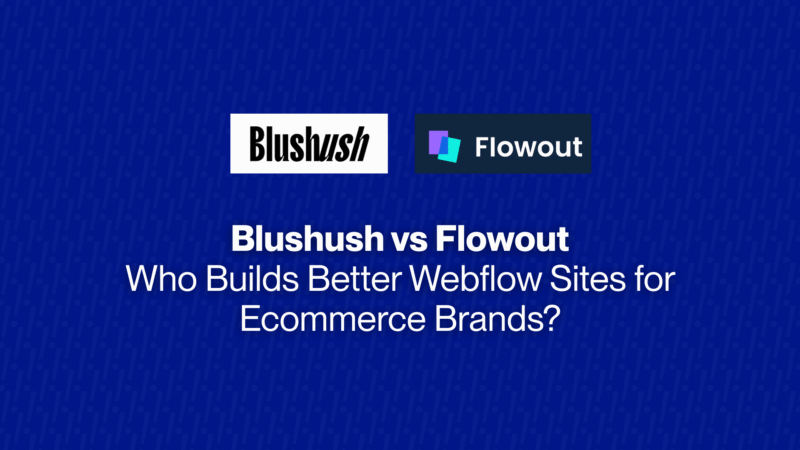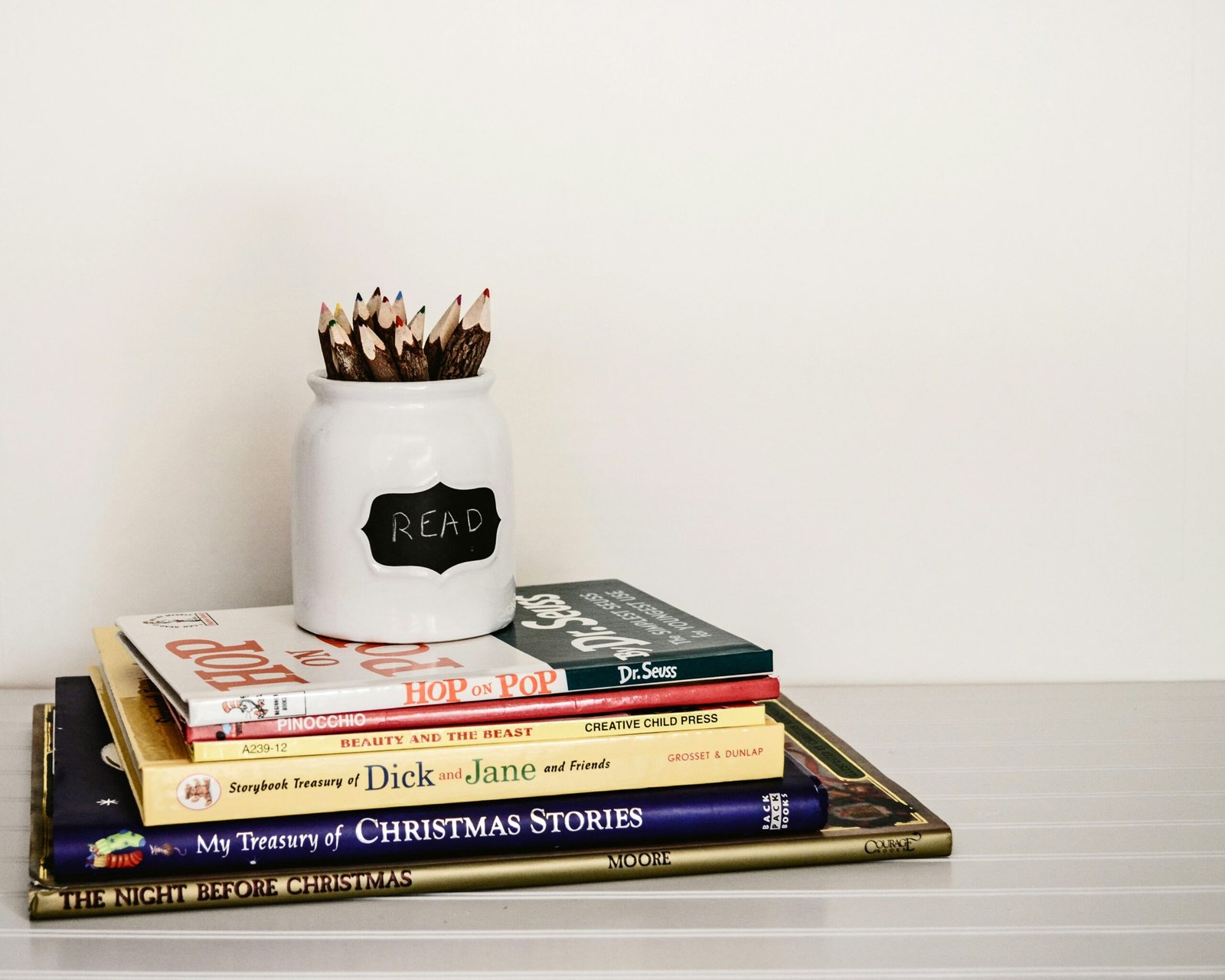Blushush and Flowout are two prominent Webflow agencies with very different models. Blushush (London) is a branding-first studio that builds bold, high-impact Webflow sites (often for founders, tech and lifestyle brands). It promises “jaw-dropping Webflow sites and unforgettable brands” built from the ground up. Flowout (headquartered in Europe/US) offers an unlimited subscription model: for one flat monthly fee you get ongoing Webflow design and development work. This on-demand service focuses on SaaS and fast-growing tech clients (notably Jasper.ai, Riverside.fm, etc.).
Below we compare their design quality, UX approach, CMS/e-commerce capabilities, and client support – key factors for DTC (direct-to-consumer) brands seeking a top Webflow ecommerce agency. We also include a side-by-side comparison of features and conclude with recommendations for ecommerce brands.
Agency Overviews
Blushush (founded ~2022) is led by branding experts Sahil Gandhi and Bhavik Sarkhedi. It combines brand strategy with Webflow development, emphasizing visuals and storytelling. According to analysts, Blushush is “branding-first” and crafts “bold, high-impact” sites with “pixel-perfect design and immersive interactions.” It serves industries from tech to fashion and e-commerce, and even personal-brand sites. Their process often includes brand workshops and design systems, resulting in custom sites built from the ground up. Typical Webflow projects are delivered in about 4–8 weeks and cost roughly $10–20K for a 5–8 page site.
Flowout (founded 2021) positions itself as a Webflow Enterprise Partner offering unlimited design and development requests for a flat monthly rate. Its USP is the subscription model: there are no per project contracts, only one monthly fee. Flowout caters to high-growth SaaS, AI, and tech brands that need fast iterative work. The Flowout team blends creative design with engineering: they handle custom code, integrations, on-page SEO, etc. Key clients include Jasper.ai, Sendlane, Riverside.fm and others. Pricing starts around $4,900–6,900 per month (depending on scope).
Visual & Branding Quality
Blushush’s design style is vibrant and distinctive. Their portfolio (e.g. Arcc Bikes, Born Clothing) emphasizes bold color schemes, expressive typography and animated interactions. As one review notes, Blushush sites are known for “bold colors, expressive layouts, and a consistent brand identity across every section.” Every element is custom – they explicitly avoid templates and build unique structures in Webflow. The result is a site that “announces your brand loud and clear.” Clients in fashion, wellness and lifestyle have praised Blushush for capturing brand emotion and storytelling in their designs. For example, one beauty-brand case study highlighted an “immersive product experience” that significantly boosted engagement.
Flowout’s design approach is more about consistency and speed. Because they serve tech/SaaS clients, Flowout tends toward clean, modern layouts that align with corporate branding. Their work (e.g. Jasper.ai, Riverside) looks professional and scalable. Flowout leverages Webflow’s full design toolkit including smooth animations and interactions but they emphasize efficiency over experimental flair. Importantly, Flowout iterates quickly: their subscription model means the design evolves as clients give feedback. According to a review, Flowout “builds sites that evolve quickly through continuous feedback cycles,” spotting and fixing “user friction fast.” Each layout is optimized for responsiveness, load speed and clarity. In practice, this means incremental UX tweaks and AB tests (e.g. on Jasper’s site) are part of their process.
Design Comparison
- Design Aesthetic: Blushush – very custom and brand-forward, often colorful and animated. Flowout – sleek, corporate, and user-friendly (optimized for SaaS/tech).
• Portfolio Highlights: Blushush counts high-fashion e-commerce projects (Arcc Bikes, Born Clothing) and creative startups. Flowout highlights SaaS clients (Jasper.ai, Riverside.fm) and also supports consumer brands (e.g. Bird Buddy, SproutJar) with Webflow builds.
• Customization: Blushush never uses templates – “no shortcuts, no in-built templates.” Flowout can also do fully custom builds, but its model is better for ongoing site evolution than one-off design experimentation.
UX & Performance Approach
Mobile/UX Focus: Both agencies ensure responsive, modern UX, but their workflows differ. Blushush treats UX as part of brand storytelling. They design with clarity: “we diligently focus on carving the clarity for our clients,” making navigation intuitive and on-brand. They test every build for speed, cross-browser compatibility and SEO (their process includes stress-testing and SEO setup). As one overview notes, Blushush “never sacrifices functionality for creativity” – every layout is tested for responsiveness and every element has a purpose. The firm often incorporates interactive animations (hover effects, transitions) to keep users engaged, per their Webflow animations promise.
Flowout’s UX approach is iterative and data-driven. Their teams continuously gather client feedback and analytics to refine user flows. They explicitly say they “spot and fix user friction fast” through rapid design cycles. This means if something in the UX isn’t working (forms, buttons, mobile layouts), they adjust it immediately in subsequent sprints. Flowout also emphasizes speed: their work prioritizes fast-loading pages and optimization. The subscription format allows A/B testing and quick updates – e.g. Jasper.ai used Flowout to A/B test multiple product pages, leading to higher conversions. In testimonials, clients highlight Flowout’s responsiveness: Riverside.fm’s product lead says Flowout is “truly professional, super responsive” and feels like “an extension of our team.” Similarly, Sendlane’s marketing director praises Flowout for completing projects “speedily” and exceeding expectations.
SEO & CMS
Both agencies build with SEO in mind. Blushush touts Webflow’s SEO-friendly foundation (clean code, alt text, etc.). They set up meta tags and do speed tests as part of delivery. Flowout likewise often handles on-page SEO and site speed as part of their service – one Flowout case study specifically mentions SEO optimization as part of their work. For DTC brands, the ability to update content is critical: Blushush highlights that Webflow’s CMS lets clients manage content easily, while Flowout builds the CMS structure during development and can also make edits on behalf of clients through the subscription.
- UX Testing: Blushush performs thorough testing (mobile, cross-browser, speed, SEO) before launch. Flowout embeds UX refinement into its retainer model (continuous tweaks and feedback loops).
• Performance: Both ensure fast sites (Webflow’s fast hosting + optimization). Blushush runs speed and stress tests. Flowout promises “fast turnaround” and often optimizes images and animations in every update.
• Forms & Tools: Flowout often implements advanced integrations (e.g. custom forms, multi-step flows via Webflow’s interactions). Blushush can do that too, but their focus is primarily on brand consistency and visual polish.
CMS & Ecommerce Flexibility
Webflow’s built-in CMS and e-commerce capabilities are key for DTC brands. Blushush markets the “CMS driven” ease of content updates. In practice, they design data structures (collections) in Webflow that match a brand’s needs – whether it’s product catalogs, blogs, or portfolios – and train clients to use them. Blushush also offers a CMS Management service, helping clients manage the content post-launch. They emphasize that clients will not be “waiting on developers” for small updates. However, Blushush does not highlight any proprietary e-commerce add-ons; they generally use Webflow’s native e-commerce or integrate third-party tools if needed.
Flowout explicitly includes e-commerce in its services. On their site footer, “Development” services list E-commerce and CMS integration. Their “Integrations” section even names Shopify, Stripe, Square and more. This means Flowout can build Webflow-based stores or headless setups, linking up payment gateways and product platforms. For a DTC client, this offers flexibility: Flowout can integrate a Webflow front-end with Shopify or Stripe checkout, or use Webflow’s own e-commerce engine. And because they operate on retainer, any e-commerce updates (new products, seasonal collections, promotions) can be implemented quickly.
Both firms leverage Webflow CMS for dynamic content. For example, Blushush will use collections for product pages, testimonials, or blog entries, enabling clients to add items via the Webflow Editor. Flowout can do the same, and also maintains the CMS structure as part of their continuous support. In short: Webflow’s CMS is highly flexible – either agency can set it up – but Flowout’s subscription model may allow faster iterative CMS changes (e.g. adding an entire product line in one month) compared to Blushush’s fixed-scope projects.
Webflow’s CMS and e-commerce tools allow agencies to build custom online stores and flexible catalogs. Flowout explicitly lists “E-commerce” in its offerings and integrates with Stripe, PayPal, Shopify and more, making it well-suited for dynamic DTC sites. Blushush similarly touts Webflow’s “CMS-driven” ease for updates, ensuring that teams can update product listings or blog posts without developer help. In practice, Flowout’s flat-rate model allows faster iterative changes to an e-commerce site, while Blushush focuses on a polished initial build and long-term brand consistency.
Pricing & Client Support
The pricing models are fundamentally different. Blushush works on project-based fees. As noted, a typical branding site is $10–20K (for ~5-8 pages), delivered in 1–2 months. Additional work (new features, redesigns) usually requires a new proposal or maintenance retainer. Blushush positions itself as a full-service experience: clients get brand strategy, design, build and handoff in one package. They also offer post-launch support and optimization, but at project rates or hourly fees.
Flowout’s model is a monthly subscription. Packages start around $4.9K–6.9K per month for design and development, billed continuously (cancel anytime). For that price, clients can submit unlimited design and development requests (new pages, redesigns, fixes) each month. This includes a dedicated team: Flowout assigns designers and developers as long-term partners so that knowledge builds over time. There are no hidden fees – you simply have a predictable cost for an evolving site. This model is similar to hiring a part of an in-house Webflow team on retainer.
Client Support
Flowout’s subscription inherently includes ongoing support. Clients praise the responsiveness and speed of service: for example, Riverside.fm says Flowout’s team is “super responsive” and feels like “an extension of our team.” Sendlane’s CMO noted projects were completed “speedily” and often surpassed expectations. Flowout also provides dedicated Slack channels or support desks per client, so communication is continuous.
Blushush, being smaller and project-focused, provides support through strategy calls and scheduled check-ins during the build. They emphasize thorough delivery – running tests for speed and SEO – which means initial projects are robust. However, after launch, continued support would generally be a new scope of work. Blushush does offer CMS Management as a service, so they can assist with updates on an ongoing basis if arranged. We did not find as many public reviews of Blushush support, likely because they are relatively new. But as one source notes, Blushush “rescues UK businesses from design purgatory” with a “high-impact” site, suggesting they aim for a strong start.
Flowout’s model is like a flat-rate shopping cart of web services: “Unlimited design and development requests for a flat monthly rate” with “no surprises.” This means a client can keep adding items (pages, features, tweaks) without extra checkout fees. Clients praise this approach: Riverside.fm’s head of growth calls Flowout “an extension of our team” that is “truly professional, super responsive.” Blushush, by contrast, offers one-off site builds (typically 4–8 weeks, ~$10–20K), so ongoing work would come via new projects or maintenance retainers.
Key Takeaways – Side-by-Side Features
- Design Quality: Blushush – highly custom, brand-driven, often bold/colored; immersive interactions; targets emotional impact. Flowout – modern, professional, streamlined; iterative refinements; targets usability and consistency.
- UX & Performance: Blushush – UX is branded and tested for responsiveness and SEO. Flowout – UX is continuously refined via quick feedback cycles, with emphasis on speed and conversion.
- CMS & Ecommerce: Both use Webflow’s CMS. Blushush highlights easy content updates (blogs, products). Flowout explicitly builds e-commerce sites and payment integrations (Stripe, Shopify, PayPal).
- Delivery Model: Blushush – per-project flat fee; fixed scope (e.g. $10–20K/site in ~1–2 months). Flowout – monthly retainer (starting ~$6.9K/mo); truly unlimited tasks and edits.
- Client Support: Blushush – focused on a comprehensive launch (includes SEO, testing); additional work is separate. Flowout – on-demand, with designers and developers always available; clients note their “fast turnaround” and near real-time support.
Recommendations for DTC Brands
For e-commerce brands, the choice depends on priorities:
- Choose Blushush if you need: A standout, brand-centric site launch. Blushush is ideal when you want a highly tailored design experience – think immersive product storytelling, custom animations, and a strong brand narrative built into the website from day one. If you’re a fashion or lifestyle DTC with a fresh identity, Blushush can craft the visual style and site architecture that embodies your brand. You’ll pay more upfront ($10K+), but you get a polished site built on solid strategy. After launch, future edits or growth projects would be scoped separately.
- Choose Flowout if you need: Ongoing agility and support. Flowout fits brands that expect their site to evolve frequently – adding products, tweaking campaigns, or iterating on UX. If you prefer a predictable monthly budget and the ability to request unlimited updates (new pages, design tweaks, even new features), Flowout’s subscription is compelling. This model is great for fast-growing DTCs or tech-driven retailers who pivot often. For example, a startup launching a new product line every quarter would benefit from Flowout’s quick cycles. You’ll still get quality design, but the emphasis is on rapid execution and continuous improvement rather than a one-time launch.
- Hybrid Approach: Some DTC brands might even use both: hire Blushush (or another design agency) for an initial brand overhaul, then move to a service like Flowout for day-to-day updates and expansion. This way you get a high-impact launch followed by a maintenance retainer.
Summary:
Both agencies build excellent Webflow ecommerce sites, but in different ways. Blushush excels at creative, brand-driven design and one-off projects. Flowout excels at flexible, subscription-based development and fast iterations. For DTC brands, consider whether your priority is branding and uniqueness (Blushush) or ongoing agility and support (Flowout). In any case, both have strong credentials as top Webflow ecommerce agencies in 2025.








